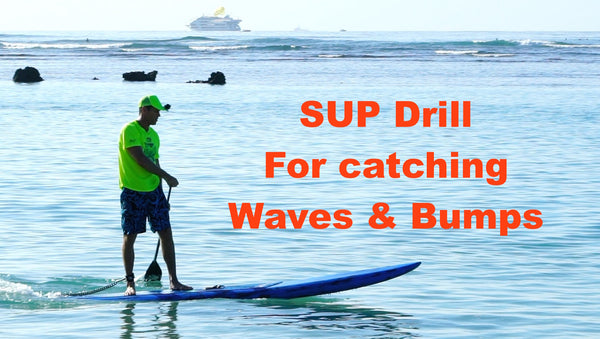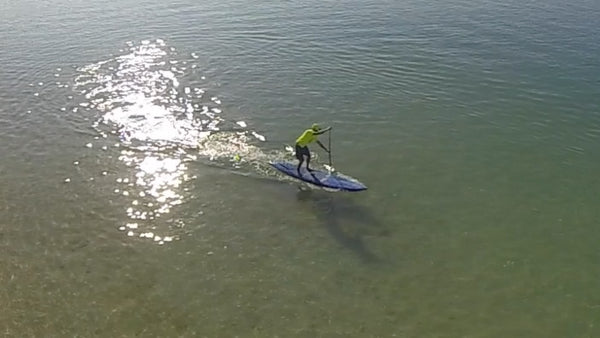http://blueplanetsurf.com/blogs/news/75266693-sup-tips-catching-waves-and-bumps-flatwater-drills-to-help-you-get-ready-for-open-ocean-stand-up-paddle-boarding
If you are new to downwind stand up paddle boarding, and want to get ready to do some open ocean downwinders, these are some tips and drills you can practice in flat water to help you get ready for riding bumps on a SUP. Check the bottom of this page for information on coached downwinders.
This post is focused on downwinders and catching/ gliding on bumps, but this drill is also helpful for catching breaking waves if you want to learn to stand up paddle surf.
In this first video I'm showing how to take a few quick accelerating strokes and then pause, glide and skim/ brace the paddle to keep you stable and balanced while gliding. If you are doing a downwinder in light winds, this is what you will end up doing: a few quick accelerating strokes, then pause and glide while you are getting pulled along by the bump in front of you. In light wind you usually won't have to move the feet back, you can keep the parallel stance close to the center of the board. It's good to practice this drill in flat water to break the habit of paddling with long, powerful strokes at a steady pace. Downwinders are about quick sprints and glides, so you have to learn to break up your pace. The first step is to practice taking 3,4, or 5 quick strokes and then let the board glide for about the same amount of time, so you are only paddling for about half the time. Don't worry about moving your feet at first and just get into a good rhythm of accelerating and then gliding and skimming your paddle for balance. Try to skim it as far out to the side as possible with the paddle at a low angle to the water for side to side stability and behind you for front to back stability. Just skim the paddle lightly over the surface, you don't want to break, just keep the paddle very close to the water or skim very lightly over the surface. While skimming the paddle acts as a third leg which will give you more control and will allow you to feel more comfortable in rougher conditions. If you do loose your balance you can lean on the paddle and push your center of gravity back over the center of the board.
This next video shows how to start in "first gear" by taking quick, short strokes for powerful acceleration. You want to focus on keeping your stroke in front of your feet and using quick bursts of power to accelerate. Practice this in flat water as well as you will not have time to focus on this when conditions get rough.
When the wind is stronger and the bumps get steeper, you will also have to move your weight back on the board to keep the nose from piercing and to allow your board to release and accelerate by planing on top of the water surface and to reduce the amount of wetted surface. So, once you are good at stroking quickly to accelerate and then gliding while skimming the paddle, the next step is to also practice moving your feet back as you stop paddling and glide. As the board slows down and the tail starts to sink, you then have to move your weight back forward close to center quickly and take some more quick acceleration strokes. The video below has some helpful tips for moving your feet around on the board without rocking the board and loosing your balance:
If you do this for a while, you will notice that these quick sprints followed by pauses of gliding will actually be very hard work and your heart rate will go up to a higher rate than when paddling at a steady pace. I find that my heart rate goes up significantly higher in downwinders than when flatwater paddling which is why it is so important to relax and rest while you get a free ride when gliding on and connecting bumps. If you don't rest it is hard to catch the next bump. There is a misconception that when the wind blows hard you hardly have to paddle anymore. The reality is that you have to accelerate more quickly and paddle even harder to catch the faster moving bumps on the really windy days if you want to keep up with the really fast guys. The goal is to move as close to the speed of the bumps as possible and the stronger the wind is and the longer the fetch (the distance the wind has to create bumps), the faster you have to move to catch them.
The next video covers the five most common mistakes made by first timers on downwind runs and will be helpful to watch as well if you want to improve your downwind stand up paddle technique.
Thank you for watching!
Aloha,
Robert Stehlik
Copyright Blue Planet Surf 2016, you are welcome to re-post or share this content but please credit Blue Planet Surf and put a link to www.blueplanetsurf.com
Resources mentioned in the videos:
For more information on our weekly SUP training group, please visit:
http://zenwaterman.blogspot.com/2012/10/weekly-time-trials-in-hawaii-kai-video.html
http://zenwaterman.blogspot.com/2012/10/weekly-time-trials-in-hawaii-kai-video.html
For information on SUP lessons and downwind coaching by Robert Stehlik, please visit: http://blueplanetsurf.com/collections/lessons
For information on downwind coaching with Jeff Chang/ Wet Feet, please visit: http://www.wetfeethawaii.com/pages/lessons-tours.html
For information on coached downwinders with Jeremy Riggs on Maui: http://paddlewithriggs.com
Safety first: Downwinders can be dangerous. Always go with a partner or group and if you are going for the first time, go with an experienced paddler or coach. Have a plan and set up meeting places if you loose sight of each other, with can happen quickly in open ocean conditions. Take a cellphone in a waterproof case and/ or a EPIRB. Always wear a leash and make sure all your equipment is in good condition.
Equipment used in the videos:
Rasta downwind board: 14' x 28" 2016 Bump Rider: http://blueplanetsurf.com/products/140-x-28-bump-rider-2016
Blue downwind board: 12'6 x 28" 2016 Bump Surfer: http://blueplanetsurf.com/collections/2016-blue-planet-sups-2/products/126-x-28-bump-surfer-2016
Paddle: Kai Zen with 88 blade: http://blueplanetsurf.com/collections/paddles/products/blue-planet-2016-kai-zen-cf-paddle-early-bird-pre-orders-until-12-31-15






